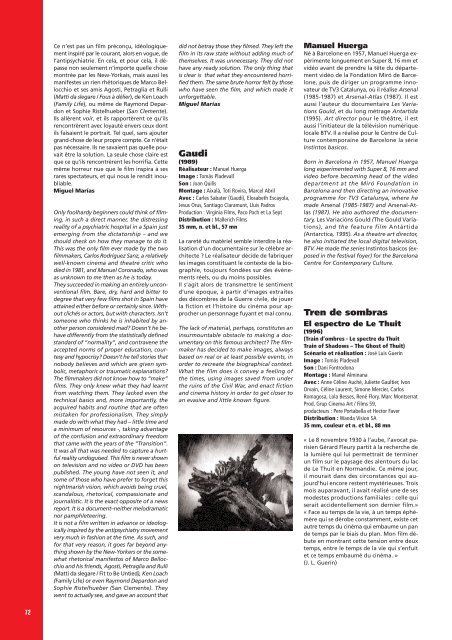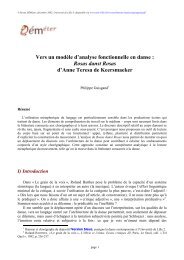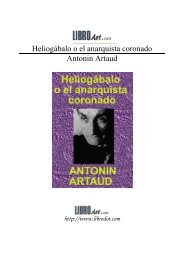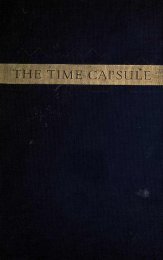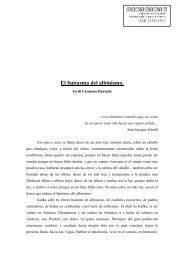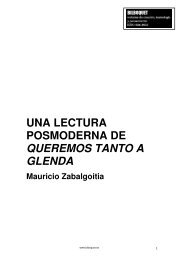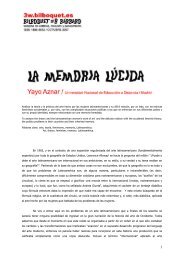Ce n’est pas un film préconçu, idéologiquementinspiré par le courant, alors en vogue, del’antipsychiatrie. En cela, et pour cela, il dépassenon seulement n’importe quelle chosemontrée par les New-Yorkais, mais aussi lesmanifestes un rien rhétoriques de Marco Bellocchioet ses amis Agosti, Petraglia et Rulli(Matti da slegare / Fous à délier), de Ken Loach(Family Life), ou même de Raymond Depardonet Sophie Ristelhueber (San Clemente).Ils allèrent voir, et ils rapportèrent ce qu’ilsrencontrèrent avec loyauté envers ceux dontils faisaient le portrait. Tel quel, sans ajoutergrand-chose de leur propre compte. Ce n’étaitpas nécessaire. Ils ne savaient pas quelle pouvaitêtre la solution. La seule chose claire estque ce qu’ils rencontrèrent les horrifia. Cettemême horreur nue que le film inspira à sesrares spectateurs, et qui nous le rendit inoubliable.Miguel MaríasOnly foolhardy beginners could think of filming,in such a direct manner, the distressingreality of a psychiatric hospital in a Spain justemerging from the dictatorship – and weshould check on how they manage to do it.This was the only film ever made by the twofilmmakers, Carlos Rodríguez Sanz, a relativelywell-known cinema and theatre critic whodied in 1981, and Manuel Coronado, who wasas unknown to me then as he is today.They succeeded in making an entirely unconventionalfilm. Bare, dry, hard and bitter todegree that very few films shot in Spain haveattained either before or certainly since. Withoutclichés or actors, but with characters. Isn’tsomeone who thinks he is inhabited by anotherperson considered mad? Doesn’t he behavedifferently from the statistically definedstandard of “normality”, and contravene theaccepted norms of proper education, courtesyand hypocrisy? Doesn’t he tell stories thatnobody believes and which are given symbolic,metaphoric or traumatic explanations?The filmmakers did not know how to “make”films. They only knew what they had learntfrom watching them. They lacked even thetechnical basics and, more importantly, theacquired habits and routine that are oftenmistaken for professionalism. They simplymade do with what they had – little time anda minimum of resources -, taking advantageof the confusion and extraordinary freedomthat came with the years of the “Transition”.It was all that was needed to capture a hurtfulreality undisguised. This film is never shownon television and no video or DVD has beenpublished. The young have not seen it, andsome of those who have prefer to forget thisnightmarish vision, which avoids being cruel,scandalous, rhetorical, compassionate andjournalistic. It is the exact opposite of a newsreport. It is a document–neither melodramaticnor pamphleteering.It is not a film written in advance or ideologicallyinspired by the antipsychiatry movementvery much in fashion at the time. As such, andfor that very reason, it goes far beyond anythingshown by the New-Yorkers or the somewhatrhetorical manifestos of Marco Bellocchioand his friends, Agosti, Petraglia and Rulli(Matti da slegare / Fit to Be Untied), Ken Loach(Family Life) or even Raymond Depardon andSophie Ristelhueber (San Clemente). Theywent to actually see, and gave an account thatdid not betray those they filmed. They left thefilm in its raw state without adding much ofthemselves. It was unnecessary. They did nothave any ready solution. The only thing thatis clear is that what they encountered horrifiedthem. The same brute horror felt by thosewho have seen the film, and which made itunforgettable.Miguel MaríasGaudi(1989)Réalisateur : Manuel HuergaImage : Tomás PladevallSon : Joan QuilisMontage : Aixalà, Toti Rovira, Marcel AbrilAvec : Carles Sabater (Gaudi), Elosabeth Escayola,Jesus Orus, Santiago Claramunt, Lluis PadrosProduction : Virginia Films, Paco Poch et La SeptDistribution : Mallerich Films35 mm, n. et bl., 57 mnLa rareté du matériel semble interdire la réalisationd’un documentaire sur le célèbre architecte? Le réalisateur décide de fabriquerles images constituant le contexte de la biographie,toujours fondées sur des événementsréels, ou du moins possibles.Il s’agit alors de transmettre le sentimentd’une époque, à partir d’images extraitesdes décombres de la Guerre civile, de jouerla fiction et l’histoire du cinéma pour approcherun personnage fuyant et mal connu.The lack of material, perhaps, constitutes aninsurmountable obstacle to making a documentaryon this famous architect? The filmmakerhas decided to make images, alwaysbased on real or at least possible events, inorder to recreate the biographical context.What the film does is convey a feeling ofthe times, using images saved from underthe ruins of the Civil War, and enact fictionand cinema history in order to get closer toan evasive and little known figure.Manuel HuergaNé à Barcelone en 1957, Manuel Huerga expérimentelonguement en Super 8, 16 mm etvidéo avant de prendre la tête du départementvidéo de la Fondation Miró de Barcelone,puis de diriger un programme innovateurde TV3 Catalunya, où il réalise Arsenal(1985-1987) et Arsenal-Atlas (1987). Il estaussi l’auteur du documentaire Les VariationsGould, et du long métrage Antartida(1995). Art director pour le théâtre, il estaussi l’initiateur de la télévision numériquelocale BTV. Il a réalisé pour le Centre de Culturecontemporaine de Barcelone la sérieInstintos basicos.Born in Barcelona in 1957, Manuel Huergalong experimented with Super 8, 16 mm andvideo before becoming head of the videodepartment at the Miró Foundation inBarcelona and then directing an innovativeprogramme for TV3 Catalunya, where hemade Arsenal (1985-1987) and Arsenal-Atlas(1987). He also authored the documentary,Les Variacións Gould (The Gould Variations),and the feature film Antártida(Antarctica, 1995). As a theatre art director,he also initiated the local digital television,BTV. He made the series Instintos basicos (exposedin the festival foyer) for the BarcelonaCentre for Contemporary Culture.Tren de sombrasEl espectro de Le Thuit(1996)(Train d’ombres - Le spectre du ThuitTrain of Shadows – The Ghost of Thuit)Scénario et réalisation : José Luis GuerínImage : Tomás PladevallSon : Dani FontrodonaMontage : Manel AlminanaAvec : Anne Céline Auché, Juliette Gaultier, IvonOrvain, Céline Laurent, Simone Mercier, CarlosRomagosa, Lola Besses, René Flory, Marc MontserratProd. Grup Cinema Art / Films 59,producteurs : Pere Portabella et Hector FaverDistribution : Wanda Vision SA35 mm, couleur et n. et bl., 88 mn« Le 8 novembre 1930 à l’aube, l’avocat parisienGérard Fleury partit à la recherche dela lumière qui lui permettrait de terminerun film sur le paysage des alentours du lacde Le Thuit en Normandie. Ce même jour,il mourait dans des circonstances qui aujourd’huiencore restent mystérieuses. Troismois auparavant, il avait réalisé une de sesmodestes productions familiales : celle quiserait accidentellement son dernier film.»« Face au temps de la vie, à un temps éphémèrequi se dérobe constamment, existe cetautre temps du cinéma qui embaume un pande temps par le biais du plan. Mon film débuteen montrant cette tension entre deuxtemps, entre le temps de la vie qui s’enfuitet ce temps embaumé du cinéma. »(J. L. Guerín)72
“At dawn on 8 th November 1930, the Parisianlawyer Gérard Fleury set out to find theright light to finish a film on the landscapearound Lake Thuit in Normandy. He died thesame day in still unelucidated circumstances.Three months previously, he had made oneof his modest family productions, and thiswas to be his last film.”“Opposite real-life time, which is fleetingand constantly slipping away, there is anothertime – the cinema’s time which embalmsa slice of time through the use of a film shot.My film begins by showing the tension thatexists between these two kinds of time, betweenreal-life, ephemeral time and the embalmedtime of cinema.” (J. L. Guerín)José Luis GuerínNé en 1960 à Barcelone, José Luis Guerínréalise, après des courts métrages en formede journaux intimes, son premier long métrage,Los Motivos de Berta (1984). Il réaliseensuite l’épisode espagnol du film collectifThe City (1988), puis, en 1990, ledocumentaire Innisfree, dans le village oùJohn Ford tourna L’Homme tranquille. AprèsTren de sombras, il réalise le long métragedocumentaire En construction (2001). Il enseignele cinéma et travaille à ses nouveauxprojets.Born in Barcelona in 1960, José Luis Guerín,after some short films in the form of a diary,made his first feature film, Los motivos deBerta (1984). He then went on to make theSpanish episode of the collective film, TheCity (1988), and the documentary, Innisfree(1990), in the village where John Ford hadmade The Quiet Man. After Tren de sombras,he made the full-length documentary En construcción,2001. He teaches cinema and is currentlyworking on his new projects.Plus qu’entre cinéastes de fiction et cinéastesdu réel, on pourrait faire le distinguoentre ceux qui croient tout savoir d’avanceet qui exécutent (aveuglement ?) un plan préalablementtracé, et ceux qui, au contraire, seposent des questions. Autant sur ce qu’ils filmentque sur la manière de filmer.Il s’agit là d’une différence tout au moins depersonnalité, sinon d’éthique. Quoi qu’il ensoit, elle a des incidences stylistiques, et peutdonner des résultats, sinon meilleurs, dumoins plus intéressants, dans la mesure oùun film conventionnel raté ne se pose pasde problème, tandis qu’un film qui cherche,même s’il n’est pas pleinement réussi, faitpenser, et que les questions posées par le cinéastese transmettent au spectateur à l’issuedu film.Je ne suis pas bien sûr qu’en d’autres temps,on se soit dit «Je vais faire un mélodrame»ou « Je vais réaliser une comédie ». Le résultatétait soit l’un soit l’autre, ou un mélangedes deux. Encore aujourd’hui, je croisque rares sont les réalisateurs qui se proposent,comme s’il s’agissait de genre, de réaliserun documentaire ou une fiction. S’il leurvient à l’esprit un sujet qui éveille leur curiosité,ou s’ils reçoivent une commande, ilscommencent par se demander commentfaire le point sur le sujet, comment approcherla question, sans savoir avec certitudeoù cela les mènera ni s’ils parviendront à unequelconque conclusion. Il arrive souvent queces films se situent, comme c’est fréquemmentle cas au cinéma, à la frontière entre« réalité » et « fiction », double origine (etpossible double destin) du cinéma depuis sesdébuts. En dehors des pays et des époquesoù le pouvoir de l’industrie est absolu, ellesrestent des possibles ouverts aux cinéastes.Dans certains cas, la manière d’approcher laréalité ou de l’approfondir, ou de la révéleren soulevant le voile des apparences, exigela création d’un dispositif, d’une trame imaginairequi permette précisément de pénétrerle réel sans se limiter à sa surface. Unexemple de ce système pourrait être Tren desombras, réalisé par José Luis Guerín entredeux documentaires moins ambigus,quoique tournés, justement, comme des fictions*.Tren de sombras part d’un found footage,un «film de famille» muet, en noir etblanc, incomplet, retrouvé dans un état dequasi-décomposition. Curieusement, alorsqu’il est tourné, visiblement mis en scènepar Guerín, beaucoup crurent qu’il s’agissaitd’un vrai film « amateur » ancien, retrouvépar Guerín et à partir duquel il avait écritune histoire en forme d’enquête policière.C’est presque le contraire, ce qui prouvel’ambiguïté de l’image cinématographiqueet la possible réversibilité du récit quand iln’est pas fondé sur la stricte causalité. Lesupposé « film ancien » est donc une faussefiction posée par Guerín – au seul moyend’un carton de début sans lequel rien nefonctionnerait – comme prétexte ou « Mac-Guffin » à une exploration hypothétique etconjecturelle de l’opacité des images cinématographiques,en évitant par cet artificeque Tren de sombras ne revête ouvertementun caractère d’essai ou ne soit qu’une purespéculation théorique. Sans qu’il soit besoinde commentaire, de dialogues ni de personnagesdirectement présents, il conditionneet transforme la manière de voir lefilm et d’assimiler l’information fournie.Il introduit – ou mieux : il ouvre une portequi nous invite à introduire – l’intrigue, ladramaturgie, les personnages et même lesuspense. Les lacunes, qui pourraient êtreattribuées au hasard ou dues au mauvaisétat de la copie, ouvrent alors de nouveauxpossibles : un certain désir illicite et enfouides opérateurs du « vieux » film de filmer –en cachette de la famille et à l’insu des personnages– la « périphérie » apparente del’action, l’oisiveté et les poses d’une familleaisée et nombreuse.Quand le film repasse sur la Moviola, la vitessechange, les images fragmentaires s’accélèrent,ralentissent ou se figent, détériorées,et c’est alors que naît le soupçon : oncroit découvrir un secret qui, en réalité, encache un autre. La reconstitution du film –non pas matérielle, mais bien plus celle deson tournage, des axes de prise de vue, desdirections de regards, du contrechamp absent(du hors champ, parfois reflété commepar hasard sur une surface brillante), des différentsplans qui stratifient l’action – sechange en enquête (non résolue) sur les activitésclandestines de certains personnages,en une hypothétique explication de l’histoiresecrète d’une famille.Il n’y a dans Tren de sombras ni parole ni récitau sens strict du terme. La majeure partiedu film, en noir et blanc, est une présentationdu film apocryphe des Fleury,succession capricieuse de scènes plus oumoins typiques du film de famille. Le filmentier, même les parties en couleurs, estmuet, bien qu’il y ait du son, de la musiqueet une ou deux phrases à peine audibles.Mais il a du rythme, de la tension, du mystère,et parfois du suspense... que se passet-il? Où va-t-on ?... Nous devinons deschoses, nous soupçonnons qu’il y a plus quecela, mais cela reste strictement imprévisible.Nous nous demandons sans cesse jusqu’àquel point c’est un film «de montage» ouun casse-tête chinois minutieusement organisé,et filmé avec une précision inouïe.Chaque plan n’est pas qu’un rectangle bidimensionnel,c’est un volume polyédrique.Nous interrogeons chaque photogramme ouce qu’il en reste. Nous le scrutons anxieusementen essayant de voir plus, de pénétrerson secret. La vieille caméra de M. Fleury,dans sa boîte doublée de velours rouge, rappelleles vieux pistolets de duel entrevus dansun vieux Max Ophuls. Un coup de tonnerre,la lune transfigurée, la pluie, évoquent unmonde de terreur et de mélodrame. Maisrien ne se passe, à ceci près que nous sentonsde plus en plus la présence des fantômesqui hantent le vieux film fragmentaireet la maison vide, peut-êtreabandonnée. Le film ne porte pas en vain lesous-titre “Le spectre du Thuit”.Est-ce nous qui rêvons devant les images quidéfilent encore et encore, qui reculent, s’accélèrentou ralentissent sur la Moviola ? Iln’y a aucune piste, aucune insinuation.Guerín laisse les images muettes parlerd’elles-mêmes, se réfléchir, se faire écho, serépondre. Il laisse les gestes et les regards sefaire mots de passe, pistes, signaux. Nouscroyons découvrir une histoire jusque là cachée,mais plus tard vient le pressentimentqu’elle en cache peut-être une autre. Sous lasurface des plus banales, conventionnelleset idylliques images de famille, se cachentde multiples intrigues possibles, des secretsqui affleurent en strates successives, en unevéritable archéologie du cinéma (rien à voiravec W. A. Ceram).Des enfants de Blow up (The Conversationou Blow Out) Tren de sombras pourrait bienêtre le plus inquiétant.Miguel Marías*Innisfree (1990) et En construction (2001)73


